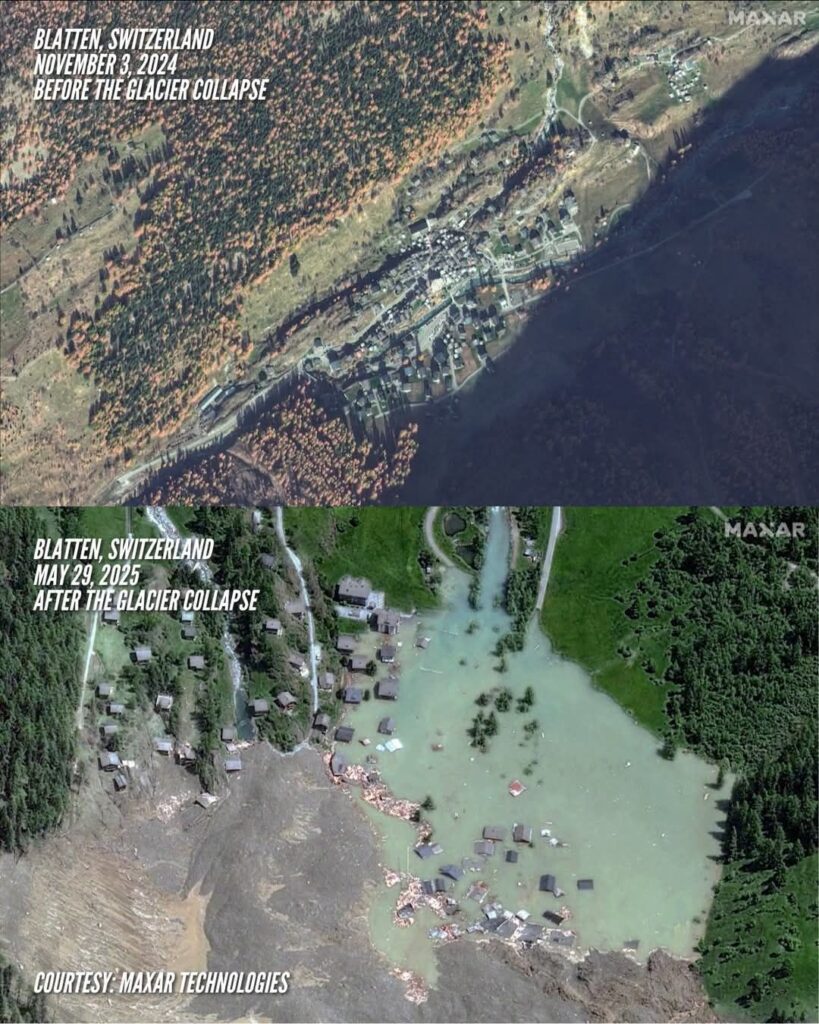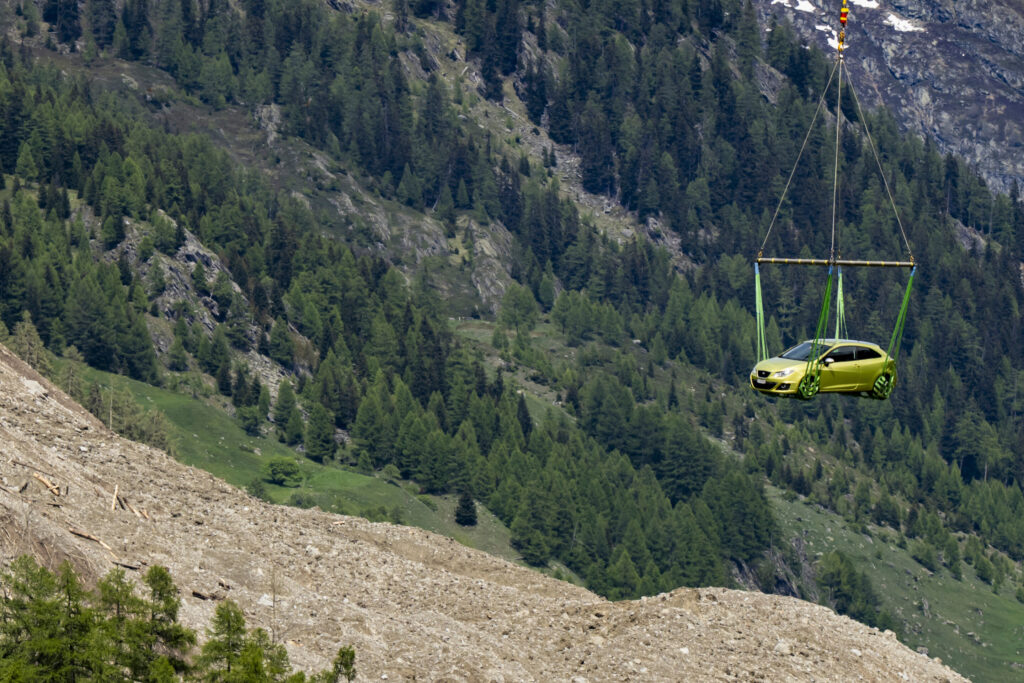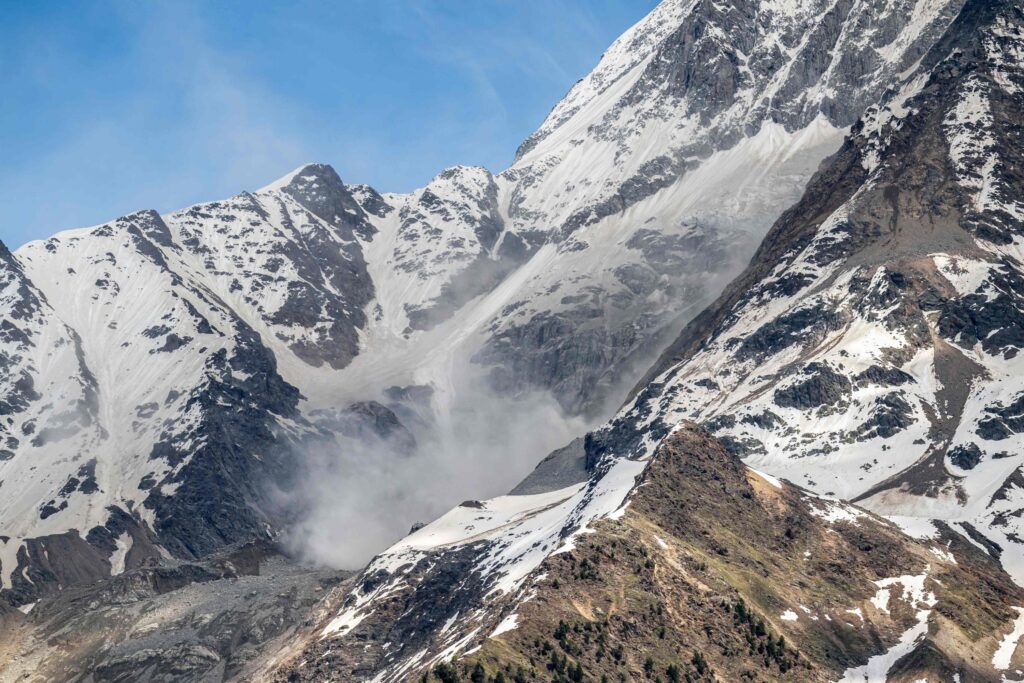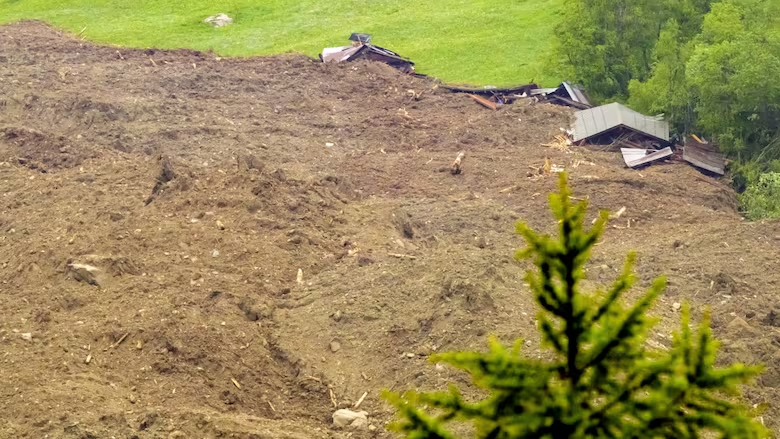June 1, 2025
On May 28, 2025, the serene Alpine village of Blatten in Switzerland’s Lötschental valley was devastated by a catastrophic landslide triggered by the collapse of the Birch Glacier. This disaster, which buried approximately 90% of the village under a deluge of ice, mud, and rock, has renewed global focus on the accelerating risks posed by climate change and retreating glaciers. The event not only obliterated homes and infrastructure but also underscored the fragility of alpine ecosystems in the face of rising temperatures.
The collapse of the Birch Glacier was a dramatic and destructive event, described by Switzerland’s Seismological Service as registering a 3.1-magnitude equivalent on the country’s seismic scale, one of the largest mass movements ever recorded in Switzerland. The glacier, located above Blatten in the Valais canton, had been under increasing strain due to a combination of environmental factors. Over recent years, the rock face above the glacier, destabilized by melting permafrost, had been shedding millions of tons of debris onto the ice. This debris, while initially insulating the glacier and slowing its melt, added immense weight, causing the ice to shift and accelerate downhill at an alarming rate—reaching 33 feet per day by May 28. The tipping point came on May 28, when a massive section of the glacier gave way, sending an estimated 3 million cubic meters of ice, rock, and mud crashing down the mountainside. Drone footage captured by Swiss broadcaster SRF showed a vast plume of dust and debris engulfing the valley, burying homes, the Lonza riverbed, and much of the surrounding landscape. “You can’t tell that there was ever a settlement there,” one resident told Reuters, encapsulating the scale of devastation.
Satellite images from Maxar Technologies, taken before and after the event, revealed a transformed landscape where buildings once stood, now replaced by mounds of debris.

Remarkably, the human toll of the disaster was minimized due to proactive measures by local authorities. On May 19, following weeks of monitoring increased glacier movement and rockfalls, officials ordered the evacuation of Blatten’s 300 residents, along with all livestock, including cows airlifted by helicopter. “When it became clear that there’s a whole mountainside that’s about to collapse,” said Martin Truffer, a Swiss-born physics professor at the University of Alaska, authorities acted swiftly to clear the village. This foresight likely saved countless lives, though one 64-year-old man remains missing, with search efforts suspended on May 29 due to unstable debris mounds.


The evacuation was prompted by signs of instability observed as early as mid-May, when millions of pounds of rock debris fell onto the glacier, accelerating its movement. Bethan Davies, a glaciology professor at Newcastle University, described the event as a “cascading disaster,” noting that warm temperatures earlier in the week exacerbated the glacier’s instability, causing visible cracks in the ice. Emergency managers had been tracking the glacier’s accelerated melt and movement, a clear indication of the mounting pressure from the debris and warming climate.
While the precise trigger of the Birch Glacier’s collapse remains under investigation, scientists widely agree that climate change played a significant role. Matthias Huss, head of Glacier Monitoring in Switzerland (GLAMOS), pointed to the melting of permafrost in the rock face above the glacier as a key factor, loosening the rock mass and contributing to the collapse. “Unexpected things happen at places that we have not seen for hundreds of years, most probably due to climate change,” Huss told Reuters.
Switzerland, home to more glaciers than any other European country, has seen alarming rates of ice loss in recent years. According to the Swiss Academy of Sciences, the country’s glaciers lost 6% of their volume in 2022 and another 4% in 2023—the two largest annual declines on record. Between 2022 and 2023 alone, Switzerland’s glaciers lost 10% of their total volume, equivalent to the ice lost over the three decades from 1960 to 1990. The Birch Glacier, unlike many others that are receding, was advancing due to the pressure of accumulated debris, making it a unique but equally vulnerable case.
Christophe Lambiel, a geologist at the University of Lausanne, noted that the glacier had been supported by a high rock face encased in permafrost, which had degraded over the past 10 to 15 years. This degradation, likely driven by rising temperatures, destabilized the mountainside, setting the stage for the catastrophic collapse. While some experts, like glaciologist Meredith Jacquemart, caution that long-term data is needed to definitively link the event to climate change, the consensus is that warming temperatures are increasing the frequency and severity of such disasters globally.

The destruction of Blatten was profound. Approximately 90% of the village, including homes, infrastructure, and the Lonza riverbed, was buried under debris, with the few remaining structures later flooded as water levels rose from the blocked river and melting ice. “We have lost our village,” said Blatten’s mayor, Matthias Bellwald, in an emotional press conference, appealing for support to rebuild. Stéphane Ganzer, head of security for the Valais canton, reported that water levels were rising by 80 centimeters per hour, raising concerns about potential flooding if the nearby Ferden Dam were to be overwhelmed, though it had been emptied as a precaution.
Residents expressed profound grief over the loss of their homes and heritage. One middle-aged woman, speaking anonymously to Reuters, said, “I lost everything yesterday,” while Werner Bellwald, a 65-year-old resident, mourned the destruction of his family’s 17th-century wooden home in the neighboring hamlet of Ried. Swiss President Karin Keller-Sutter, cutting short a trip to Ireland to visit the site, expressed solidarity, stating on X, “It’s terrible to lose your home.”
The disaster also disrupted the region’s infrastructure, with the main road into the Lötschental valley closed due to ongoing hazards. Emergency services warned of further rockfalls, and the area was deemed too dangerous for residents to return. The economic and cultural impacts are significant, as Blatten, nestled in the picturesque Alps, was a tight-knit community tied to traditional alpine practices like “summering,” where livestock graze in high pastures—a way of life now threatened by the loss of the village and the broader retreat of glaciers.
The Birch Glacier collapse is not an isolated incident but part of a global pattern of glacier instability driven by climate change. In Peru, for instance, a 2023 study found that over half of the country’s glacier surface has been lost in the last six decades, with 175 glaciers vanishing between 2016 and 2020. A glacial lagoon overflow in April 2025 triggered a landslide that killed two people, echoing the dangers seen in Switzerland. Similarly, in Alaska, annual flooding in Juneau has been linked to bursting lakes formed by retreating glaciers. A study published in Science on May 29, 2025, warned that even if global temperatures stabilize, 40% of the world’s glaciers could still disappear, though limiting warming to 2.7°F (1.5°C) could preserve twice as much ice.
Switzerland’s glaciers, often called “Europe’s water tower,” are critical for water supply, agriculture, and hydropower. Their rapid retreat—60% since 1850—threatens not only local communities but also downstream ecosystems and economies across Europe. The collapse of the Marmolada glacier in Italy in 2022, which killed 11 people, and the redrawing of the Swiss-Italian border in 2024 due to melting ice under the Matterhorn highlight the broader regional impacts of glacier loss.
The Blatten disaster has reignited calls for urgent action to address climate change and mitigate its impacts on alpine regions. Scientists like Lonnie Thompson of Ohio State University emphasize that glacier instability is a “real and growing problem,” putting thousands at risk worldwide. The Swiss Commission for Cryosphere Observation has urged immediate measures to stabilize the climate and protect remaining glaciers, warning that even large glaciers like the Aletsch, a UNESCO World Heritage Site, could vanish within a generation.
For Blatten, the path to recovery is uncertain. Mayor Bellwald remains optimistic, declaring, “Blatten has a future,” but rebuilding will require significant resources and planning to address ongoing risks. The disaster serves as a stark reminder of the need for enhanced monitoring, early warning systems, and adaptive strategies in glacier-dependent regions. As Switzerland grapples with the loss of its icy heritage, the world must heed the warning: the melting of glaciers is not just a loss of natural beauty but a harbinger of cascading disasters that demand global cooperation to address.




Hey there!
Welcome to Moviezhive.com, where blockbuster entertainment is just a click away!
Stream a vast collection of Bollywood, Hollywood, and international movies for free—no subscriptions, no hassles.
What Makes Us Special?
✔️ Thousands of movies across all genres
✔️ Zero pop-up ads for seamless viewing
✔️ Advanced zero-buffering tech for smooth playback
✔️ Fresh titles added regularly
Can’t find a movie? Request it, and we’ll upload it fast!
Watch anytime, anywhere. Visit https://moviezhive.com now and start your movie adventure!
Enjoy the Show,
The Moviezhive Team